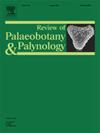北美西北太平洋地区具有文化价值的植物物种的植化石特征描述
IF 1.7
3区 地球科学
Q2 PALEONTOLOGY
引用次数: 0
摘要
古生态学和考古学研究经常利用土壤植金石来了解过去的植被变化和人类对植物的长期利用,尤其是驯化栽培品种。然而,要利用植物植化石进行准确的解释和分析,需要收集特定地区的参考资料。有大量研究记录了在全球禾本科物种(由于其植物岩石产量高)和热带地区双子叶植物中观察到的植物岩石形态,但对于北美西北太平洋等温带地区的双子叶植物,却缺乏植物岩石参考资料。本研究旨在通过记录在 60 种具有重要文化价值的植物食品、药物和纺织品(均以双子叶植物为主)中观察到的植物岩石形态,填补这一空白。根据植物特定部位(如茎、叶、花)的丰富程度对植物岩石进行分类,并将研究结果与其他地方研究的近缘物种进行比较。结果表明,西北太平洋地区的许多双子叶植物物种比世界各地的近缘物种产生更多的植金石,这可能是由于不同的环境因素影响了植物植金石的产生。这些发现有助于在古生态学背景下评估植被变化或识别以双子叶植物为主的生态系统,如土著栽培和管理的森林以及其他以多年生果树/灌木为主的景观。此外,本文研究的三个物种可能显示了诊断性的植物托叶,但还需要进一步确认。未来的研究应考虑影响植化石产生的局部环境模式,从而影响我们对植化石分类学和沉积学/形貌学的理解。本文章由计算机程序翻译,如有差异,请以英文原文为准。
Phytolith characterization of culturally salient plant species of the Pacific Northwest of North America
Palaeoecological and archaeological studies often use soil phytoliths to gain insight into past vegetation changes and the long-term use of plants by people, particularly domesticated cultivars. However, to make accurate interpretations and analyses using plant phytoliths, regionally-specific reference collections are warranted. There is ample research documenting phytolith morphotypes observed in grass species worldwide (due to their high phytolith production), and of dicots in tropical regions, but there is dearth of phytolith references for dicot species in temperate regions like the Pacific Northwest of North America. This study aims to fill part of this gap by documenting phytolith morphotypes observed in 60 culturally important plant foods, medicines, and textiles, all predominantly dicot species. Phytoliths are classified by abundance in specific plant parts (e.g., stem, leaf, flower) and the findings are compared to closely related species studied elsewhere. Results indicate that many of the dicot plant species in the Pacific Northwest produce more phytoliths than closely related species worldwide, likely due to differing environmental factors which affect phytolith production in plants. These findings could be useful in palaeoecological contexts to assess vegetation changes or identify dicot-dominated ecosystems, like Indigenous cultivated and managed forests and other perennial fruit tree/shrub dominated landscapes. Additionally, three of the species studied here showed possible diagnostic phytoliths but further confirmation is warranted. Future studies should consider localized environmental patterns affecting phytolith production, and therefore, our understanding of phytolith taxonomy and deposition/taphonomy.
求助全文
通过发布文献求助,成功后即可免费获取论文全文。
去求助
来源期刊
CiteScore
3.50
自引率
21.10%
发文量
149
审稿时长
6 months
期刊介绍:
The Review of Palaeobotany and Palynology is an international journal for articles in all fields of palaeobotany and palynology dealing with all groups, ranging from marine palynomorphs to higher land plants. Original contributions and comprehensive review papers should appeal to an international audience. Typical topics include but are not restricted to systematics, evolution, palaeobiology, palaeoecology, biostratigraphy, biochronology, palaeoclimatology, paleogeography, taphonomy, palaeoenvironmental reconstructions, vegetation history, and practical applications of palaeobotany and palynology, e.g. in coal and petroleum geology and archaeology. The journal especially encourages the publication of articles in which palaeobotany and palynology are applied for solving fundamental geological and biological problems as well as innovative and interdisciplinary approaches.

 求助内容:
求助内容: 应助结果提醒方式:
应助结果提醒方式:


